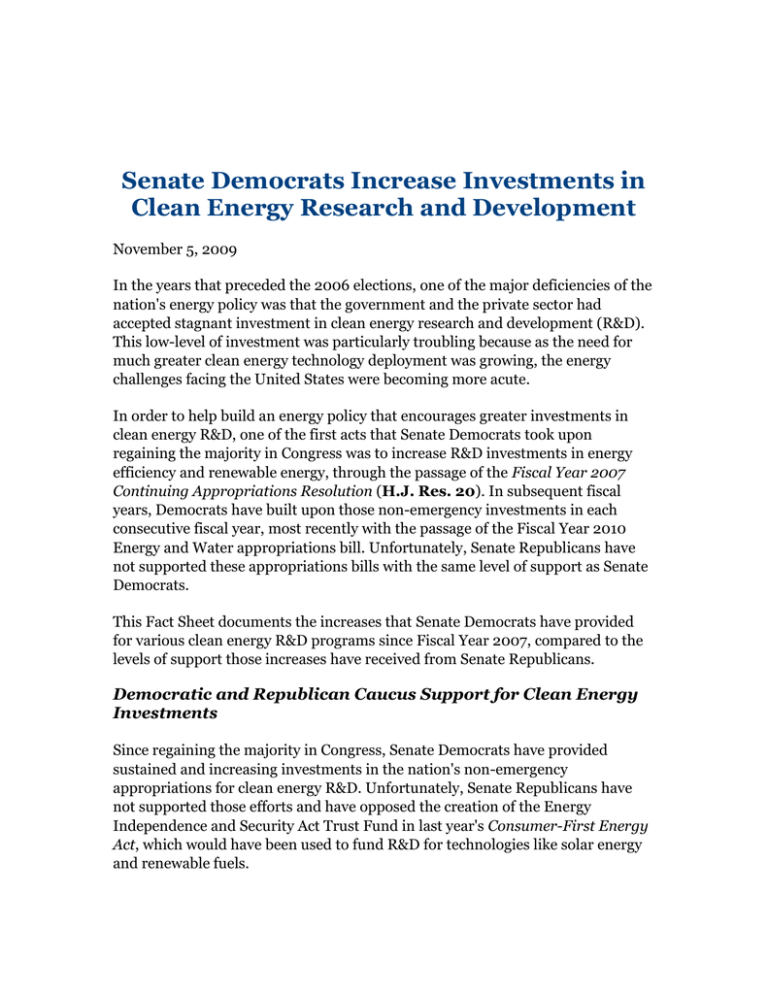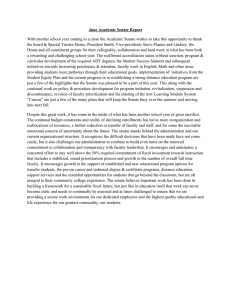Senate Democrats Increase Investments in Clean Energy Research and Development
advertisement

Senate Democrats Increase Investments in Clean Energy Research and Development November 5, 2009 In the years that preceded the 2006 elections, one of the major deficiencies of the nation's energy policy was that the government and the private sector had accepted stagnant investment in clean energy research and development (R&D). This low-level of investment was particularly troubling because as the need for much greater clean energy technology deployment was growing, the energy challenges facing the United States were becoming more acute. In order to help build an energy policy that encourages greater investments in clean energy R&D, one of the first acts that Senate Democrats took upon regaining the majority in Congress was to increase R&D investments in energy efficiency and renewable energy, through the passage of the Fiscal Year 2007 Continuing Appropriations Resolution (H.J. Res. 20). In subsequent fiscal years, Democrats have built upon those non-emergency investments in each consecutive fiscal year, most recently with the passage of the Fiscal Year 2010 Energy and Water appropriations bill. Unfortunately, Senate Republicans have not supported these appropriations bills with the same level of support as Senate Democrats. This Fact Sheet documents the increases that Senate Democrats have provided for various clean energy R&D programs since Fiscal Year 2007, compared to the levels of support those increases have received from Senate Republicans. Democratic and Republican Caucus Support for Clean Energy Investments Since regaining the majority in Congress, Senate Democrats have provided sustained and increasing investments in the nation's non-emergency appropriations for clean energy R&D. Unfortunately, Senate Republicans have not supported those efforts and have opposed the creation of the Energy Independence and Security Act Trust Fund in last year's Consumer-First Energy Act, which would have been used to fund R&D for technologies like solar energy and renewable fuels. The following chart demonstrates the support in the Democratic and Republican caucus in the Senate for increased non-emergency clean energy investments. Office of Energy Efficiency and Renewable Energy The Department of Energy's (DOE) Office of Energy Efficiency and Renewable Energy plays an important role in supporting R&D for technologies like wind, solar, and biomass. In Fiscal Year 2007, Senate Democrats provided $1.474 billion for DOE's Office of Energy Efficiency and Renewable Energy, which was $301 million more than the Fiscal Year 2006 enacted level; In Fiscal Year 2008, Senate Democrats provided $1.722 billion for DOE's Office of Energy Efficiency and Renewable Energy, which was $248.1 million more than the Fiscal Year 2007 enacted level; In Fiscal Year 2009, Senate Democrats provided $1.929 billion (excluding the funding provided by the Recovery Act) for DOE's Office of Energy Efficiency and Renewable Energy, which was $206.1 million more than the Fiscal Year 2008 enacted level; In Fiscal Year 2010, Senate Democrats provided $2.243 billion for DOE's Office of Energy Efficiency and Renewable Energy, which was $313.9 million more than the Fiscal Year 2009 enacted level. Overall, since the passage H.J. Res. 20 in 2007, Senate Democrats have increased the overall investment in DOE's Office of Energy Efficiency and Renewable Energy by $768.2 million. This represents a 51 percent increase in funding for DOE's Office of Energy Efficiency and Renewable Energy over the four-year period. Energy Efficiency and Renewable Energy Programs While the passage of H.J. Res. 20 was an important achievement in helping to spur non-emergency investments in clean energy technologies, the legislation was written in the form of a Continuing Resolution because the prior Republican Congress had been unable to complete their work on 9 of the 11 annual appropriations bills. This gave the DOE the ability to allocate the $1.474 billion appropriation for DOE's Office of Energy Efficiency and Renewable Energy at their discretion. That is, the DOE had the ability to provide as much or as little funding for programs like solar, geothermal, biomass, and weatherization assistance. In 2008, Congress passed the Consolidated Appropriations Act of 2008 (H.R. 2764), which allocated funding to DOE programs like solar, geothermal, biomass, and weatherization assistance. The following information describes the sustained and increasing levels of non-emergency funding that Senate Democrats have provided for those programs from Fiscal Year 2008 through Fiscal Year 2010: Solar Wind Biomass Geothermal Water Power Vehicle Technologies Building Technologies Industrial Technologies State Energy Program Fossil Energy Research and Development The Department of Energy's Office of Fossil Energy plays an important role in supporting R&D for clean coal technology (fuels and power systems). Overall, since the passage of H.R. 2764 in 2008, Senate Democrats have increased the overall non-emergency investments in clean coal technology by $54.3 million or 16 percent. In 2008, Congress passed the Consolidated Appropriations Act of 2008 (H.R. 2764), which allocated funding to DOE programs like carbon capture and sequestration. The following information describes the sustained and increasing levels of non-emergency funding that Senate Democrats have provided for those programs from Fiscal Year 2008 through Fiscal Year 2010: Carbon Capture and Sequestration Innovations for Existing Plants Electricity Delivery and Energy Reliability The Department of Energy's Office of Electricity Delivery and Energy Reliability plays an important role in modernizing the nation's electricity grid through R&D activities on transmission and reliability, Smart Grid systems, energy storage, and cyber security. In Fiscal Year 2010, Senate Democrats provided $124.9 million for R&D activities within DOE's Office of Electricity Delivery and Energy Reliability. This amount is $40.2 million more than the Fiscal Year 2009 enacted level and $39.7 million more than the Fiscal Year 2008 enacted level. The following chart illustrates the overall increases that Senate Democrats have provided for R&D activities within the Department of Energy's Office of Electricity Delivery and Energy Reliability. The following information describes the sustained and increasing levels of nonemergency funding that Senate Democrats have provided for programs within DOE's Office of Electricity Delivery and Energy Reliability from Fiscal Year 2008 through Fiscal Year 2010: Smart Grid Energy Storage Cyber Security and Energy Delivery Systems DPC
